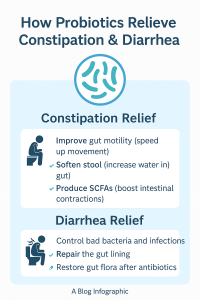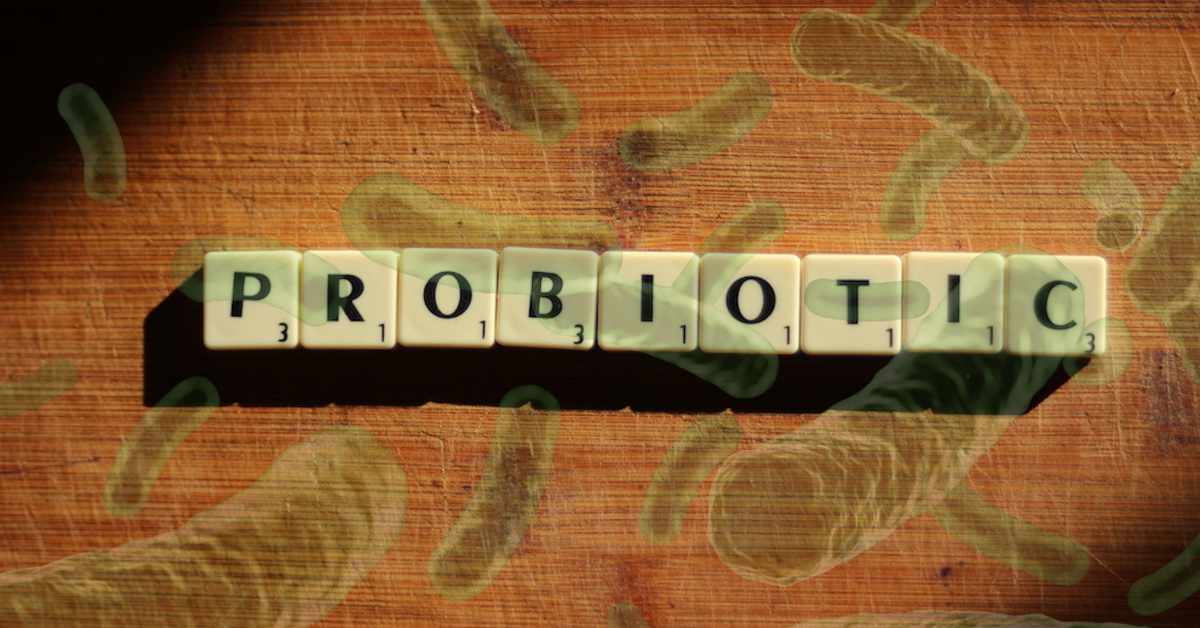Probiotic meaning
Probiotics are live microorganisms (bacteria/yeast) that, when administered in an adequate amount, give health benefits to the body.
For example, when we eat curd, it provides beneficial bacteria to our gut, which help relieve acidity, reduce flatulence, ease constipation, and even support recovery from diarrhea. In this example, we got probiotics from curd. Probiotics are also known as good bacteria.
Probiotics are live bacteria present in our large intestine, which help in digestion.
Probiotics in the human body
Where are probiotics present in the human body?
- Large intestine.
- Skin, mouth, and female reproductive tract.
- Probiotics are transferred to babies born with a natural delivery.
Natural Probiotic Bacteria Examples in the Human Body:
Probiotic Bacteria work Lactobacillus breakdown Lactose, reduce acidity Bifidobacterium helps in Constipation Streptococcus thermophilus repair gut lining
Why do we need Probiotics?
You might wonder — if probiotics already exist in our body, why do we need to consume them from outside?
Daily stress, junk food, antibiotics, pollution, and certain disease conditions, where the natural probiotic load declines, can hurt our health. However, the addition of probiotic foods can have a positive impact on our health.
Benefits of Having Probiotics
- Improves Digestion
- Relieves Constipation & Diarrhea
- Strengthens Immunity
- Reduces Gas, Bloating & Acidity
- Improves Mood and Mental Well-being
- Better Skin Health
- May Help Lower Cholesterol
1. Improves Digestion
- Probiotics, especially Lactobacillus and Bifidobacterium, help in the breakdown of complex food particles.
- For example, it helps in the digestion of lactose (milk sugar) through the formation of the lactase enzyme.
- Probiotics improve gut lining and enhance absorption of Calcium, magnesium, and vitamin B12.
2. Relieves Constipation & Diarrhea

1. Constipation Relief
✅ Improve Gut motility:
Probiotics activate hormones ( motilin), which regulate the movement of the intestine, causing undigested food in these regions to move into the large intestine. In this way, it helps with constipation.
✅Soften Stool :
Some probiotic strains (like Bifidobacterium lactis)retain water in the gut, which makes stools soft and easy to pass.
✅ Fermentation se SCFAs banate hain:
Probiotics break down dietary fiber and make short-chain fatty acids (SCFAs). These SCFAs:
-
nourish the intestinal lining.
-
trigger Peristalsis (gut contraction)
In short, SCFAs help in regular and comfortable bowel movements.
2. Diarrhea Relief
🦠 How probiotics work in diarrhea:
✅ Controlling bad bacteria :
A major reason for diarrhea is the presence of harmful bacteria or viruses.
Probiotics:
-
Stop the growth of harmful microbes
-
Help in controlling the spread of infection
✅ Repair gut lining:
In diarrhea, the gut lining becomes weak
-
Probiotics strengthen the gut barrier
-
Improve absorption of nutrients & water
✅ Effective in Antibiotic-associated diarrhea:
Antibiotics kill both good and bad bacteria.
Probiotics, such as Saccharomyces boulardii and Lactobacillus rhamnosus GG, help restore gut flora and alleviate diarrhea.
Scientific Strains That Help:
Constipation: Bifidobacterium lactis, Lactobacillus casei
Diarrhea : Saccharomyces boulardii, Lactobacillus rhamnosus GG, Bacillus coagulans
3. Strengthens Immunity
70% of Immune Cells Live in the Gut
Yes — your gut isn’t just for digestion.
It’s the home to 70% of your body’s immune system, known as GALT (Gut-Associated Lymphoid Tissue).
GALT is a vital part of the immune system that protects the body from infections in the gut. It acts as a defense network, controlling the body’s response to food, bacteria, and viruses.
Where is GALT found?
-
Small intestine (especially the ileum)
-
Large intestine
-
Tonsils
-
Appendix
-
Peyer’s patches (clusters of immune cells inside the gut wall)
Connection with Probiotics:
-
Probiotics help GALT stay active & healthy.
-
They stimulate GALT to build better immune tolerance and antibody protection.
Best Probiotic Strains for Immunity:
| Strain | Benefit |
|---|---|
| Lactobacillus rhamnosus GG | Fights respiratory infections |
| Bifidobacterium lactis | Enhances gut immunity |
| Lactobacillus casei | Boosts NK cell activity |
4. Reduces Gas, Bloating & Acidity
- Gas and bloating often occur due to bad bacteria and fermented, undigested food.
- Probiotics outnumber bad bacteria and reduce excess fermentation and gas formation.
-
Some strains (like Lactobacillus reuteri and Lactobacillus acidophilus) regulate stomach acid levels, helping prevent: Hyperacidity, Reflux, and Indigestion.
-
Improves Mood and Mental Well-being
5. Improves Mood and Mental Well-being
The gut is often known as the “second brain.”That’s because it’s deeply connected to your brain through a powerful link called the gut-brain axis.
-
The gut and brain constantly communicate through nerves (especially the vagus nerve) and chemical messengers.
- Studies suggest that probiotics can increase serotonin production in the gut.
- Serotonin– the “feel good” hormone (90% of it is made in the gut)
- Probiotics don’t just support digestion — they also boost brain function, reduce stress, and help you feel calmer and happier.
Probiotic Strains Shown to Improve Mental Health
| Strain | Benefit |
|---|---|
| Lactobacillus helveticus | Reduces anxiety and stress |
| Bifidobacterium longum | Boosts mood, reduces depression |
| Lactobacillus rhamnosus | Supports emotional balance |
6. Better skin health
- Probiotics affect the gut-skin axis
- The gut-skin axis refers to the bidirectional relationship between the gut microbiome and the health of the skin.
- Probiotics reduce inflammation, clear toxins, and improve your skin’s hydration, glow, and resilience.
A. Oral Probiotics (through food or supplements)
| Probiotic Strain | Skin Benefit |
|---|---|
| Lactobacillus rhamnosus | Reduces acne and eczema |
| Lactobacillus plantarum | Improves skin barrier, hydration |
| Lactobacillus casei | Anti-inflammatory, helpful in rosacea |
| Bifidobacterium longum | Calms stress-induced skin reactions |
| Lactobacillus acidophilus | Reduces breakouts, improves gut-skin axis |
| Bifidobacterium breve | Protects against UV damage, hydrates skin |
B. Topical Probiotics (for direct skin application)
These work on the skin surface by restoring the skin microbiome and soothing irritation.
| Probiotic Ingredient | Application & Effect |
|---|---|
| Lactobacillus ferment | Found in serums/creams, protects the barrier, soothes redness |
| Bifida ferment lysate | Anti-aging improves skin elasticity and repairs |
| Streptococcus thermophilus | Boosts ceramide production (moisturizes skin) |
7. May help lower cholesterol
- Probiotics help lower cholesterol naturally.
- Some probiotic strains (like Lactobacillus and Bifidobacterium) break down bile salts in the intestine, and the liver uses more cholesterol to make bile salts; in this way, more cholesterol is utilized.
-
Probiotics produce SCFAs like acetate, propionate, and butyrate.
-
These SCFAs inhibit cholesterol synthesis in the liver, resulting in lower total cholesterol and triglyceride levels.
Best Probiotic Strains for Cholesterol Management:
Strain Action Lactobacillus reuteri (e.g., NCIMB 30242) Clinically shown to reduce LDL by 8–12% Lactobacillus plantarum Improves lipid profile Lactobacillus acidophilus Helps lower total cholesterol Bifidobacterium longum Reduces triglycerides
Probiotic Foods That Support Cholesterol Health:
-
Curd/yogurt (with live cultures)
-
Buttermilk (Chaas)
-
Miso / fermented soy
-
Fermented oats (Indian kanji or porridge)
-
Kombucha (moderate amounts)
This article is for informational purposes only, aimed at helping you understand the role of probiotics and the importance of gut health in our daily lives.
There are multiple probiotics, and their use is specific and different according to the patient’s health. Please consult a health practitioner before self-prescribing.

